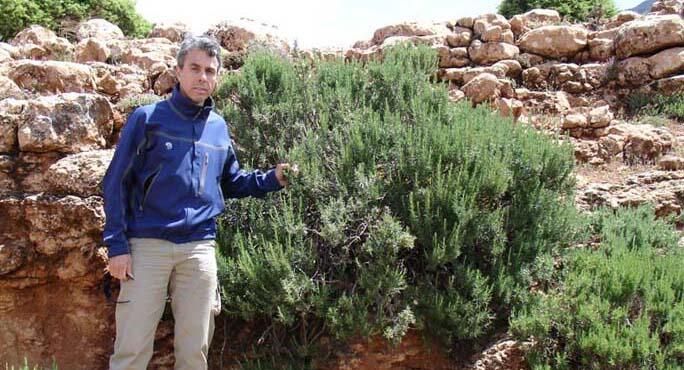
Chris with Rosemary, Morocco. Photo by: Axel D'Hauthille © 2009
Common Name
Botanical Name
Rosemary leaf consists of the whole or cut leaves, fresh or dried, of Rosmarinus officinalis and its preparations in effective dosage.
Pharmacopeial grade dried rosemary leaf contains at least 1.2% essential oil. Rosemary is a fragrant and bushy evergreen shrub with linear aromatic leaves, native to the Mediterranean basin and Portugal, now cultivated in England, France, Spain, Portugal, Morocco, South Africa, India, China, Australia, the United States, and along the Crimean peninsula in Transcaucasia. Rosemary is often grown as a garden ornamental. A common spice, rosemary is used to flavor meat, soups and stews. 1,2,3
Rosemary has a long tradition of use as a tonic, stimulant, and to relieve headaches, head colds, nervous tension and indigestion. The herb is used to relax spasms, relieve pain, stimulate the liver, and improve digestion. Rosemary is a symbol of friendship, loyalty and remembrance, and has historically been carried by mourners at funerals. Greek scholars wore garlands of rosemary ostensibly to sharpen their wits. In India, rosemary enjoys a history of use as a stimulant and as a carminative - to expel gas from the stomach and intestines. Rosemary oil is used in soaps and perfumery.2,3,4,5
Phytochemicals and Biological Activity
Rosemary contains volatile oils, flavonoids and phenolic acids. Some notable constituents include camphor, cineole, alpha pinene and borneol. The powerful antioxidant proerties of rosemary make the herb and its preparations valuable for food preservation. Rosemary compares favorably to the common preservative BHT - butylated hydroxytoluene. The herb contains the flavonoid diosmin, which protects capillary integrity. Phytochemicals in rosemary demonstrate hundreds of biological activities, including antioxidant, anti-inflammatory, antifungal, antibacterial, antispasmodic, antiviral, anticancer, antitumor against various tumors, anesthetic, analgesic, anticonvulsant, cancer-preventive and liver protective properties.6,3,7
Germany’s Commission E approves the internal use of rosemary leaf for dyspeptic complaints and external use as supportive therapy for rheumatic diseases and circulatory problems.8
The European Scientific Cooperative On Phytotherapy lists the internal use of rosemary and its preparations to improve hepatic and biliary function and in case of indigestion, and external use of rosemary preparations for the treatment of rheumatic conditions, peripheral circulatory disorders, promotion of wound healing, and as a mild antiseptic.
Nature's Way's Rosemary Leaves (Capsules) is a good product, and Herb Pharm makes an excellent Rosemary Extract. Or for cooking, try Simply Organic's Certified Organic Rosemary in soups, stews and sauces, with apples and other fruits. Enjoy its balsamic tone in herb vinegars and salad dressings as well as breads (rosemary and olive oil focaccia, for example).
References:
- Wichtl M, Bisset NG (eds.). Herbal Drugs and Phytopharmaceuticals. Trans from 2nd German ed., (Stuttgart: Medpharm GmbH Scientific Publishers. 1994)
- Leung, A.Y. and S. Foster. 1996. Encyclopedia of Common Natural Ingredients Used in Food, Drugs and Cosmetics, 2nd ed. New York: John Wiley & Sons, Inc.
- Bown, Deni. The Herb Society Of America Encyclopedia of Herbs & Their Uses. (1st ed., (New York: Dorling Kindersley,1995)
- Nadkarni, A., Dr. K.M. Nadkarni’s Indian Materia Medica. 3 rd ed. (Popular Prakashan Bombay, India 1994)
- Evans, W.C., Trease and Evans’ Pharmacognosy, 13th ed., (Philadelphia, Bailliere Tindall, 1989)
- Bruneton J. Pharmacognosy, Phytochemistry, Medicinal Plants. 2nd ed., (Paris: Lavoisier Publishing 1993)
- Dr Duke’s Phytochemical and Ethnobotanical Databases, February 5, 2006
- Blumenthal M, Goldberg A, Brinckmann J (eds). Herbal Medicine: Expanded Commission E Monographs. 1st ed., (Newton, MA: Integrative Medicine Communications. 2000)
- ESCOP. 1997. "Rosmarini folium." Monographs on the Medicinal Uses of Plant Drugs . Exeter, U.K.: European Scientific Cooperative on Phytotherapy

